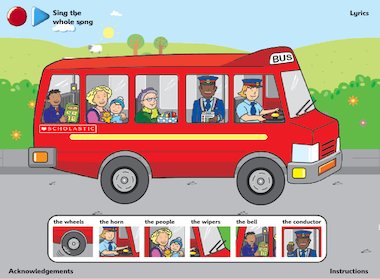The actual big yellow school bus that pulls up on the corner may complete your consummate picture of motherhood, apple pie and sending your kids off to a great education. But the area of the picture that many don’t see is the amount of it costs to maintain that big, yellow, gas-guzzling auto operating safely, on time period and operating well. Paying to operate the fleet of wheels on the bus song for baby
buses just stands out as the silent problem that maintains many a school board member awake during the night time.
According to the Countrywide Highway Traffic Safety Supervision, school buses are the safest mode of transportation to and from school in the united states. Each year, approximately 450, 000 general public school buses travel roughly 4. 3 billion a long way.
Keeping them rolling, on the other hand, requires fuel — as well as that’s been expensive in recent times. School boards and university systems’ management are constantly seeking strategies to economize their school bus fleet through better operations and optimizing routes and controlling their flow.
Inefficient routing and rising fuel costs have become a cost burden about operating budgets, and have lead district transportation managers to turn to technology to build efficiency where and once possible.
Global Positioning Systems (GPS) are one technology. GPS systems offer not merely positioning information in actual or delayed time, it gives vehicle position background, travel route, with velocity and time, student i . d ., emergency alert and robotic accident notification.
The Wheels on the bus songs
became one of many first school districts in the united kingdom to implement GPS solutions in its school buses in the past. The district has a number of 43 schools — 35 elementary schools, eight midst schools and five higher schools, and approximately nineteen, 750 students.
Kansas Open public Schools outfitted GPS-enabled gadgets onto the district’s 157 buses, allowing instant voice communication between drivers plus the district’s transportation office. The solution provided the dispatcher web site give school bus motorists their mapped route along with driving directions and moment expectations, and allowed drivers the capacity to contact 911 in the emergency.
The school district was focused on safety as a main priority, like most school districts. Integrating GPS was ways to deploy technology to permit administrators and dispatchers to find out and locate the status of the school bus transporting young children, in real time.

School transportation planners which use technology-assisted route advancement and route-planning software has to be careful to not business off efficiency for safe practices. Route-planning technology can always be limited in its role in number of school bus stops. Care has to be taken not to place a greater priority on efficiency in comparison with safety. For example, locating a school bus stop with a secondary street may remove the bus from an arterial that has a more direct option.
GPS handsets helped and even cruise directors maintain and operate a simple yet effective bus transportation department, permitting them to monitor and make one of the most efficient use of bus scheduling demands. The Global positioning system unit wirelessly transmits real-time location information towards the dispatch center to a server where data is monitored because of the district’s transportation department making it possible for transportation officials to monitor the positioning of the buses. The information is monitored along the route as they pick up and drop off students. This is another feature that allows school authorities to deliver vigilance and ultimately more safety for that pupils’ whereabouts.
The location of each bus might be displayed on a map so administrators could see and know where buses are at any moment; in addition, the same may be displayed on a mobile phone. Knowing this and other information about where and when the bus travels allows analysis for being performed to determine along with efficient route and time for you to travel that prevents idling and distance
.
When the Funds Drives the Bus
What are the results when your board involving education says cut your allowance and there’s no easy destination to cut without it impacting the underlying program? Nicely it happened in Lansing, N. Y.
Recently, the board of schooling in Lansing posed a surprise challenge to their Vehicles department — cut the actual budget by $90, 000. Lansing school buses move some 1, 222 individuals over 300, 000 miles yearly and transport students in order to private schools, vocational software programs, athletic events and assist many school events.
The board of transportation had a whole new challenge. They sought the assistance of technology that could probably help them by rescheduling tour bus routes and travel instances. They purchased software by Transfinder — a provider of transportation management software to a lot of school districts. It allowed Lansing to help reroute their school buses and ultimately travel carefully computed distances that have been most efficient and consumed the least fuel. Applied against a total fleet of school buses, the savings in fuel consumption can add up. They did in reality accommodate their $90, 000 challenge, by knowing where their buses were, where they had to be and pinpointing the shortest distance to make it happen. Consequently, the shorter distances translated to be able to shorter travel times and also ultimately lower incremental fuel consumption.
Making decisions about exactly where school bus stops are going to be placed requires balancing conditions that might be ideal with the realities of your community’s road system, temperature and topography. In this kind of discussion, ideal characteristics tend to be described, but these characteristics will rarely all be met for each school bus stop. Transportation directors must seek to perform everything possible for student safety with not very good conditions.
The Lansing transportation board use their fresh software to plan as well as optimize routes, and utilized GPS technology to are the reason for real-time positions of the institution buses. The software allowed them to see granular information such as who was on your bus and what roadwork could possibly impact schedules.
By getting rid of inefficient bus runs, reducing mileage and the next effects of all of these factors on other functioning expenses, they easily made their $90, 000 reduction target — in fact it was more
like $100, 000.
Cutting down Operating Costs in More Ways Than One
Lansing isn’t really the only community employing location engineering for bus route search engine optimization. Many other communities are carrying it out as well.
Several in the past, the Nash Rocky Mount Public Schools in Rocky Mount, N. C., used routing software with regards to buses but didn’t possess as firm a grip for the whereabouts of their buses since they would have liked. They looked to a product from Daily Solutions, Inc., a service of GPS-driven transportation data for K-12 marketplace.
They had the ability to use the data in the AVL software to lower your expenses in fuel and maintenance costs by making sure that the bus is making the correct number of stops and also driving the planned paths — the shortest ones and not some other route of their own making.
The same company also took around the Charlotte County Public Educational institutions (CCPS), in Port Charlotte, Fla., after the transportation director in the district felt they didn’t employ a real good sense of these day-to-day transportation operations after the buses left the element. In the first year of when using the software, CCPS was capable to employ optimized routes, pickups and recommendations in their operations to achieve recognizable savings.

There had been a 15- to 20-minute big difference between actual driving instances versus reported driving occasion — which CCPS states saved them $50, 000 in a single year. Add to that another $4, 000 in fuel expenses by reducing unnecessary idling in the engines and, ultimately, many people really reduced their entire costs.
GPS technology and route-planning software would possibly not work for every university system, district or knowledge board; however, in today’s trim and mean budgetary times, technology of this type might easily pay for itself in a short period given the rising cost of fuel and school buses. Talk to a new school board representative, and it will sound like a new broken record — demand is the same for education, however the budget is strangled. In times like these, a dollar put down today inside name of efficiency can mean greater dollar returned in fuel savings in a few years or less.













